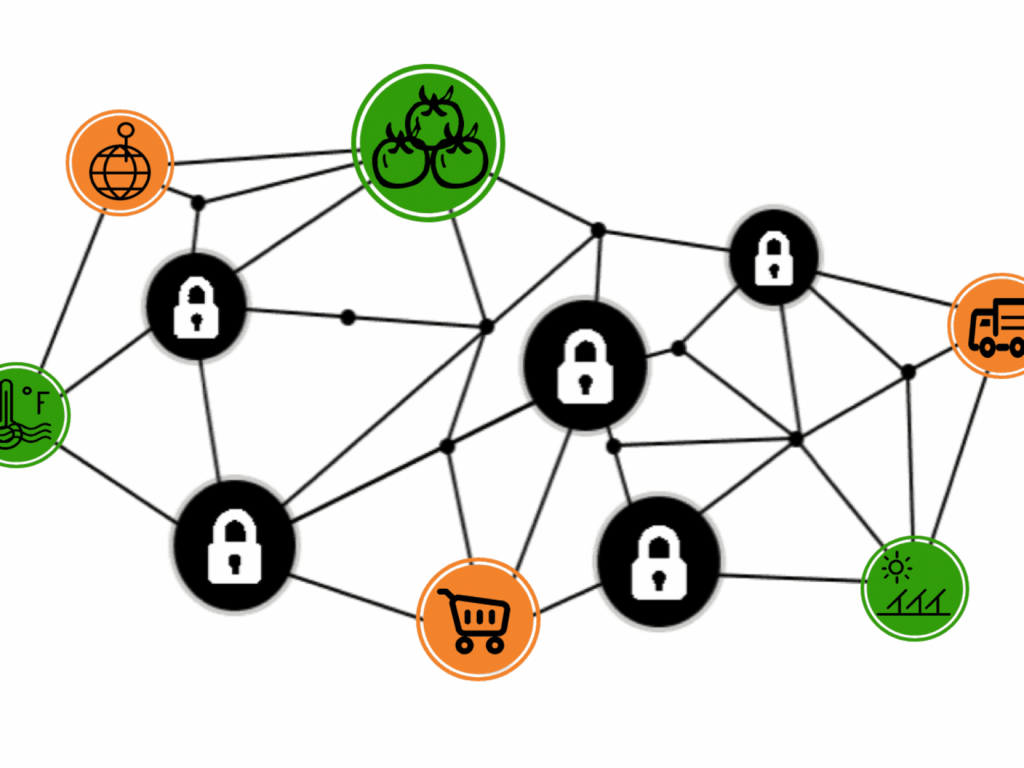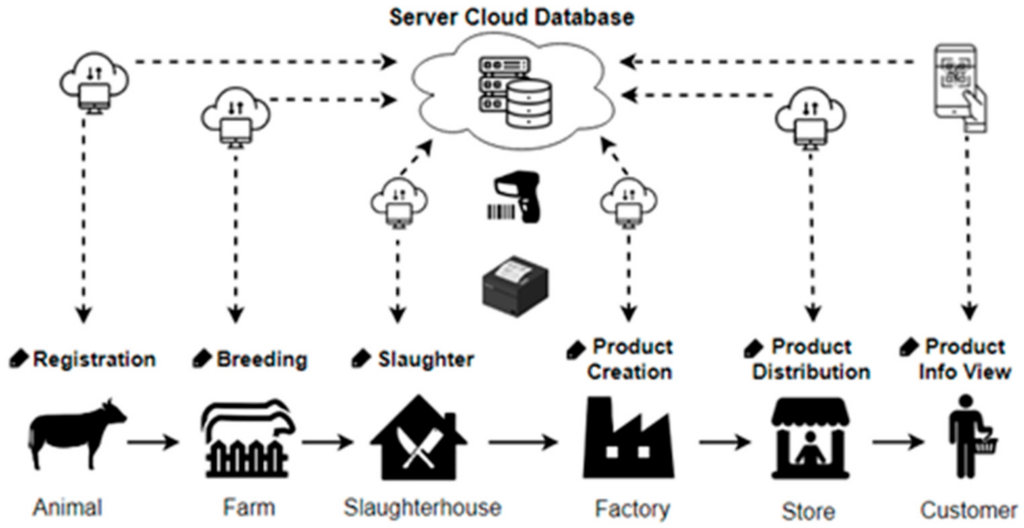Bootstrap Azure Subscription for DevOps
Imagine this: a juicy tomato plucked from the vine on a farm thousands of miles away. It is travelling through a network of suppliers, processors, and distributors before hitting the shelves of your local grocery store. It's a journey full of potential hazards, from contamination to mislabeling. Stressing once again the critical need for airtight food traceability with blockchain.

Food traceability is the ability to trace the journey of a food product from farm to fork. It's about knowing where our food comes from and how it's been handled. And with that ensuring that it meets the highest quality standards.
But why is it so important to have an airtight food traceability with blockchain? Picture this scenario: a widespread outbreak of foodborne illness sends shockwaves through communities. The ability to quickly trace the source of contamination can mean the difference between life and death. It's about protecting public health, restoring consumer confidence, and preventing future crises.
Blockchain is a distributed database that records transactions in a series of blocks, forming a chain that's immutable and transparent. Each block contains a cryptographic hash of the previous block, creating a digital fingerprint. This fingerprint links them together in a chronological and tamper-proof sequence.
But what sets blockchain apart from traditional databases is its decentralized nature. Rather than relying on a single central authority to validate transactions, blockchain operates on a peer-to-peer network. Where each participant – or node – contributes to the validation process.
This decentralized consensus ensures that no single entity can manipulate the data. This makes blockchain inherently resistant to fraud, censorship, and tampering. Which is essential to improving food traceability.
Picture this: a global network of farmers, processors, distributors, and retailers. Each of them are a link in the chain, vulnerable to a variety of risks and uncertainties. It's a complex ecosystem where even the slightest hiccup can have far-reaching consequences.
So, what are some of the challenges in food traceability? At the forefront lies the issue of transparency – or rather, the lack thereof. Supply chains are fragmented, information can get lost in transition. Making it difficult to track the journey of food products throughout the supply chain.
But transparency is just one piece of the puzzle. Inefficiencies are also there, making the industry's efforts to ensure the safety and quality of our food hard. From manual record-keeping to siloed data systems, the current state of traceability is full of inefficiencies. It limits the timely and accurate tracking of food products.
And then there's the issue of accountability – or rather, the lack thereof. In a system where responsibility is diffused across actors, tracing the source of a food safety issue can be troublesome. Without a clear chain of custody, identifying the origin of a contamination event becomes mission impossible.

So, how can we improve food traceability with blockchain?
Imagine a world where every step of a food product's journey is transparent. From the farm to table each activity and movement is recorded on a transparent and immutable ledger.
Whether it's the harvesting of crops, processing of ingredients, or shipping goods. With blockchain each transaction is timestamped, verified, and permanently stored. This creates an unbroken chain of custody, allowing stakeholders to trace the provenance of food products with accuracy and confidence.
At its essence, blockchain serves as the digital backbone of food traceability. It is a decentralized ledger that records every step of a food product's journey with precision. From the moment a crop is harvested to the instant it lands on a consumer's plate, blockchain captures every transaction. Whether its a transfer of ownership or change in status.. Every activity is stored as an immutable record.
But perhaps the true power of blockchain lies not in its ability to record data. It could be in its potential to accelerate collaboration and innovation across the food supply chain. By providing a shared platform for sharing information, blockchain enables stakeholders to work together more effectively. Streamlining processes, and building trust in the safety and quality of our food.
Beyond blockchain, lies a world of innovation and possibility. By combining AI, IoT, and RFID we can drastically improve the way we trace the food on our plates.

The illustration depicts a schematic outline of a cloud-native architecture for a food traceability system. (ref: academic paper).
Imagine a future where every tomato, every egg, every grain of rice is embedded with a tiny sensor. A beacon of data that communicates its every move in real-time. This is the promise of IoT – the Internet of Things. An extensive network of sensors, scanners, and smart devices facilitates the tracking of every step in a food product's journey.
But IoT is just one piece of the puzzle. Enter AI. From predictive analytics to anomaly detection, AI algorithms offer insights and foresight that were once unimaginable. Enabling us to anticipate risks, optimize processes, and enhance the safety and quality of our food.
And then there's RFID – the radio-frequency identification technology that's been quietly revolutionizing the world of supply chain management for decades. With RFID tags embedded in every product, every pallet, every shipment, we get visibility into all the movements of a product.
There is a wide range of laws, standards, and guidelines – each designed to govern different aspects of food traceability. From the Food Safety Modernization Act (FSMA) in the United States to the General Food Law in the European Union. These regulations set the stage for a safer, more transparent food system – outlining requirements for record-keeping, labeling, and traceability.
As technology for food traceability continues to expand, we face new challenges and opportunities in ensuring compliance with existing regulations. How do we reconcile the principles of blockchain with the requirements of traceability regulations? How do we ensure interoperability between different systems and platforms?
This can only be achieved by close collaboration and standardization with initiatives such as improving food traceability with blockchain.
One of the most important challenges is scalability. How can blockchain and AI cope with the vast volumes of data generated by the food supply chain each day? How do we ensure that our systems can handle the exponential growth of data without sacrificing performance or security?
Interoperability presents another significant hurdle. Stakeholders across the food industry seek to adopt blockchain and other traceability solutions. But how do we ensure that these systems can seamlessly communicate and share data? How do we prevent the creation of silos that hinder collaboration and efficiency?
Data privacy emerges as a critical consideration in an era of heightened concerns about cybersecurity and consumer privacy. How do we strike the right balance between transparency and confidentiality? Thereby ensuring that sensitive information is protected without compromising the integrity of the traceability system or actors within?
Resistance to change poses yet another challenge. The food industry characterized by its deeply entrenched practices and traditions. How do we overcome skepticism and inertia to get widespread adoption of new technologies? How do we empower stakeholders to embrace innovation and adapt to the changing demands of the digital age?
This blog highlights how transparency, trust, and teamwork are crucial for keeping our food safe and reliable. From dealing with challenges like growth and working together on new tech and rules, there are plenty of chances to make a difference.
But among these hurdles, there are opportunities to create a future where everyone can easily track where their food comes from, where producers can closely follow their products, and where we all work together for food safety and quality.
Looking ahead, it's clear: the road ahead is all about trying new things, working together, and getting better every day. By using new tech, pushing for better rules, and keeping things open, we're making sure everyone can trust their food.
Ready to improve your food traceability as a food manufacturer? Great! Your first step is to have all your data properly made available in a managed data & analytics platform!
Let us know where we can help!
Engage supply chain stakeholders like farmers, processors, and consumers. Proof of concepts (PoCs) can pinpoint challenges and opportunities. Moreover, establishing interoperability standards is crucial for seamless integration with current IT setups.
Establishing quality control procedures is essential for overseeing IoT device performance and identifying anomalies or malfunctions. Furthermore, deploying data encryption and authentication methods safeguards data integrity and security.
By utilizing historical data on food safety incidents and supply chain disruptions, AI algorithms can predict risks in traceability data.
User-friendly dashboards and visualizations offer clear, actionable risk assessments and recommendations.